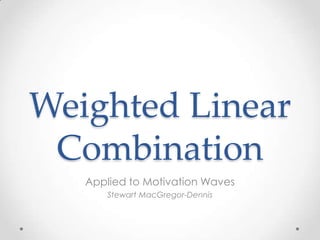
Motivation wave level
- 1. Weighted Linear Combination Applied to Motivation Waves Stewart MacGregor-Dennis
- 2. Abstract • A weighted linear combination is a type of evaluation function used in artificial intelligence, where an evaluation function is an equation that returns a score for a particular state1. A state is just what the world looks like right now (i.e. your immediate environment, current level of social pressure to exercise, etc). Using a weighted linear combination as an evaluation function is a step towards the automation of anticipating and recognizing when someone is in a motivation waves. Using this function and an appropriate data set, we could search through a set of possible behavior design interventions to find which one maximizes a person’s motivation score. In practice, we would most likely want to balance this motivation score against changes in their ability to act and trigger levels too2. 1. Russell, Stuart J., and Peter Norvig. Artificial Intelligence: A Modern Approach. Englewood Cliffs, NJ: Prentice Hall, 1995. Print. 2. Fogg, BJ. A Behavior Model for Persuasive Design. N.p., n.d. Web. <http://www.bjfogg.com/fbm_files/page4_1.pdf>.
- 3. Variables • Way of recognizing motivation waves: • Conducive environment • Already a habit • Factor: • Factor: • ENV = Conduciveness of environment • TIME = Length of time since began habit for specific behavior • Way of recognizing motivation waves: • Authority / Friend Request • Way of recognizing motivation waves: • Factor: • Prolonged inactivity • SOC = measure of social pressure • Factor: • Way of recognizing motivation waves: • INACT-TIME = Time inactive • Survival from bad health • Way of recognizing motivation waves: • Factor: • Extreme emotions • HSURV = Current health profile score • Factor: • Way of recognizing motivation waves: • EMO = Emotional score • Survival from physical risks • Way of recognizing motivation waves: • Factor: • Self-reflection/realization • RSURV = Current risk profile score • Factor: • Way of recognizing motivation waves: • REFLECT = Quality of self- • Social norms reflection/realization • Factor: • Way of recognizing motivation waves: • STRNORM = Strength of associated • Imaginary judgement social norms • Factor: • Way of recognizing motivation waves: • IMAG-JUDGE = presence of imaginary judgement Ngo, David. "9 Ways to Recognize Motivation Waves." 9 Ways to Recognize Motivation Waves. N.p., n.d. Web. 27 Oct. 2012. <http://www.slideshare.net/dngo11/9-ways-to-recognize-motivation- waves>.
- 4. Evaluation Function • Motivation = 0.1 * TIME + 0.15 * SOC + 0.1 * HSURV + 0.125 * RSURV + 0.75 * STRNORM + 0.175 * ENV + 0.1 * INACT-TIME + 0.025 * EMO + 0.1 * REFLECT + 0.05 * IMAG-JUDGE
- 5. Next steps • Write a program to implement the function. • Start testing the function with different data sets. • Apply learning/optimization to get a more accurate weighting of the variables.